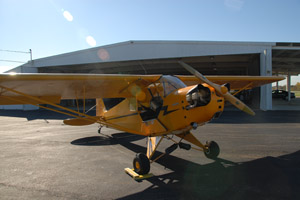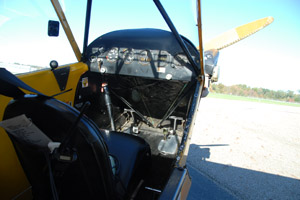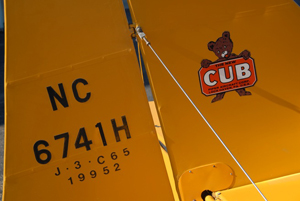My Tail’s Dragging
MEDINA, Ohio — He oversees the fixed-base operations at Ohio’s Medina Airport, so it makes sense that Earle Olsen loves airplanes. He owns seven. A Duke, an Ercoupe, a Stearman, a few others I haven’t seen yet, and his little two-seat pride and joy, the Piper J3 Cub.

1946 Piper J3 Cub
Ask any former kid from the last century to draw a picture of a Duke and you’ll surely get a blank stare. Ask him to draw a Piper Cub, and he’ll need just two crayons — one yellow, and one black — to quickly render a little airplane with a high wing above, Cheerio-shaped black tires below and a matching black bolt of lightening to streak the length of a bright yellow fuselage.
Cubs have been around for a long time. They first appeared in the late 1930’s, and when the U.S. faced the inevitability of the Second World War, the J3 quickly became the primary aircraft of the Civilian Pilot Training Program. The demand for pilots pushed factories into overdrive, and one J3 rolled off the assembly line every 20 minutes at the height of wartime production. By the war’s end, a staggering 80 percent of all U.S. military pilots had received their initial flight training in one of Mr. Piper’s Cubs.
The cockpit will freeze you in the winter, and clambake you in July
Olsen’s J3 is a 1946 model and it has outlasted many of the pilots who flew it when it was new. Like all other Cubs of this vintage, it has a cockpit that will freeze you in the winter, and clambake you on the tarmac in July. There are two seats in tandem and you fly solo from the back. It lacks any modern avionics because it also lacks an electrical system. The 65-horsepower Continental engine keeps the wooden propeller turning once it has been pulled around by hand to get started. If you happen to be airborne in a fresh breeze and want to try to keep up with cars on the interstate highway below, you’ll need to lean forward and stick out your tongue.

J3 Cockpit
A J3 is low-tech. It is from another time. But it lingers on in mine, and I wanted to learn how to fly one before both of us became extinct. So long as there is a good mechanic around to properly care for a flying time machine like this one, the odds are the airplane will last forever. Pilots, on the other hand, have a limited shelf life.
A warm breeze carried me into Medina on a blustery day in August with a sky full of broken cumulus left over from a rainstorm scudding off to the northeast. There was just enough blue in the sky to make a pair of trousers for a sailor, and I saw Earl Olsen’s well-maintained Cub as it was parked on the ramp near the grass. The Cub’s yellow fabric bloomed bright against all that green, compliments of a shaft of sunlight passing through a hole in the clouds at exactly the same time I turned to look. These few moments of illumination were like a siren’s song. I was transfixed. I wanted to fly it right then. But I had never flown one before and — it had a tail wheel.
All of the airplanes I have ever flown have had a nose-wheel. Aeronautical engineers learned a long time ago that putting the third wheel in the front moves the center of gravity forward and makes the aircraft more stable to take-off and land. These days, learning how to fly a taildragger typically calls for a good bit of “transition” training for pilots who have spent all their time in airplanes with tricycle gear. The FAA requires a certified flight instructor’s endorsement to fly on conventional gear, and a lot of underwriters won’t insure you unless you have a minimum of 10 hours of dual instruction in the aircraft type beforehand. Watch pilot explain flying a taildragger.
Another thing — there aren’t many flight instructors teaching students how to fly taildraggers in the 21st century, and it is just as rare to find an airplane to rent. Nonetheless, that little tail wheel out back was the calling card for an exclusive club of aviators stretching clear back to 1930. They could tame it, and its predisposition to dangerously swap ends when mishandled, so why not I?
Compared to most modern airplanes, the J3’s performance is modest. The airplane is also as light as a kite, and is just as susceptible to the wind. “Just keep it straight on landing and fly it until it is parked,” an old military pilot once told me. It’s still a machine that can kill you. What it lacks in performance, it more than makes up for in charm. The tube and fabric construction, its simplicity in a complicated world continue to beguile the child and the dreamer with the same delightful promise — “together we can fly.”
I read the books and heard the stories. Some likened a crosswind landing in a J3 to balancing a broom vertically in the palm of your hand while simultaneously trying to push a two-wheeled suitcase in a straight line while running. If I could learn to do this, there was hope of not ruining Earl Olsen’s 62-year old aeronautical treasure.
To put your life in danger from time to time breeds a saneness in dealing with trivialities
I had an old taildragger training manual in my flight bag when I met Jim Seymour at the airport. Jim works at Medina as a flight instructor and is one of those rare individuals with enough gumption and skill to strap his bottom into a J3 with a stranger, and attempt to inject the taildragger’s ancient art into the novice pilot’s limbs and spirit. Nevil Shute once said, “To put your life in danger from time to time breeds a saneness in dealing with trivialities.” Back in 1938, Shute worked as an aeronautical engineer and I think if he were around today he and Jim Seymour would get along just fine.
Seymour, of course, is Earle Olsen’s only real insurance that a tyro taildragger pilot will not convert the J3 into a wrinkled heap of smoking fabric and metal. But everyone knows even a good instructor can save a student from himself only some of the time. It takes just a few seconds of inattention to tumble an airplane into a ball. If I really mess up in the J3 with Jim onboard, I am confident the wreckage will be found precisely on the centerline of the runway — instead of out in the bushes somewhere. As for the smaller transgressions that are part of this courtship, only the three of us will know, and I expect the Cub will likely forgive me.
So here I am. Stick in hand, the tail is up, and I am riding in a two-wheeled suitcase hurtling down the runway. Jim and Nevil must be smiling, as right now everything trivial has ceased. This Cub is without a doubt, consciously timeless — and I’m feeling joyfully sane.
Copyright © 2008 Joe Murray

Sorry, the comment form is closed at this time.